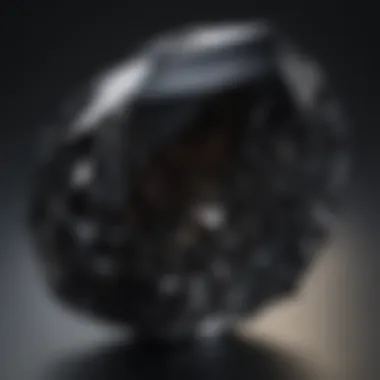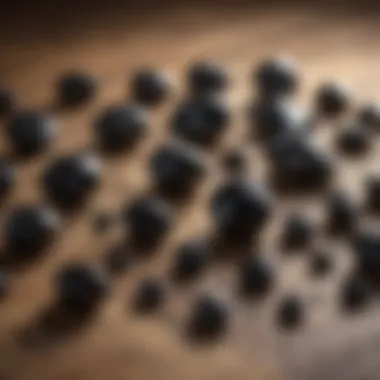The Enigmatic Beauty of Black Crystal Stones Revealed


Intro
Black crystal stones have captivated people's interest for millennia, not only for their beauty but also for their enigmatic qualities. These remarkable geological formations can be found in various parts of the world. Their deep, rich colors, often contrasting sharply with lighter minerals, make them desirable for collectors and enthusiasts alike. Through this article, we aim to explore the charm of black crystals, guiding our readers in their journey of discovery, whether they are seasoned collectors or just new to the world of geology.
Rock and Fossil Identification
Identifying black crystal stones begins with understanding their classifications. It is essential to recognize the uniqueness of different types of rocks and crystals.
Types of Black Crystals
- Obsidian: A volcanic glass formed from rapidly cooled lava, this crystal exhibits a shiny surface and sharp edges.
- Hematite: Often appearing metallic and reflecting light, hematite is an iron oxide and has significant weight when held.
- Onyx: Layered with shades of black and different colors, onyx is often polished for aesthetic purposes.
Characteristics to Look For
When examining black crystals, certain characteristics should be prioritized. These include:
- Color Uniformity: Evenness in color is often a sign of quality. Variations may indicate a lower quality or mixed composition.
- Clarity: Higher-quality stones exhibit little to no inclusions or blemishes.
- Weight: The heft of the stone can give clues; lead-heavy options are generally of better quality, often indicating the presence of more dense minerals.
Tools for Identification
To accurately identify and evaluate black crystal stones, several tools can be beneficial:
- Magnifying Glass: A magnifier assists in inspecting the stone for surface details.
- Scale: Use a precise scale to determine the weight of the specimens, which helps in comparison.
- Field Guide: A geological field guide provides insight into various types and properties of minerals.
Preface to Black Crystal Stones
The study of black crystal stones holds significant importance for collectors and enthusiasts in both geological and aesthetic terms. These stones exhibit unique features that often capture the imagination. Their allure stems from not only their stunning visual appeal but also their fascinating origins and historical significance. Numerous individuals appreciate them for their distinctive traits and what they represent in various cultures.
Defining Black Crystal Stones
Black crystal stones are generally characterized by their rich black coloration, resulting from various geological processes. Their opaque nature sets them apart from more transparent gemstones. In the mineralogy field, these stones can boast characteristics that help differentiate them. The most notable aspects include their luster, hardness, and unique internal structures.
Some well-known black crystal stones are obsidian, black tourmaline, black onyx, and black spinel. Each conforms to specific mineral classifications while sharing common traits through rich geological formation. Replicated beauty is often a driving force behind their desirability.
Historical Context
Throughout history, black crystal stones have been imbued with mystique and significance. Various cultures across the globe have utilized these stones, assigning different meanings to them. For instance, ancient Egyptians regarded black stones as symbols of protection and fertility. This usage transcended merely ornamental purposes.
Black crystals featured prominently in spiritual and ritualistic practices among indigenous tribes too. Such historical implications have solidified the stones' status, making them coveted items for collectors.
Geological Origins of Black Crystals
The geological origins of black crystals provides foundation for understanding their significance and appeal to collectors. These stones, formed through various processes over millennia, are more than just visually striking; they embody stories of elemental transformation and resilient survival through natural events. Knowing where they come from enhances appreciation for their rarity and value, while also informing collection strategies.
Formation Processes
Black crystal stones originate through complex geological processes. Typically, formations start in environments prone to volcanic or metamorphic activity. For instance, obsidian results from the rapid cooling of lava, resulting in a glass-like texture. The intricate slice of molten material cools when ejected or poured out during eruptions, giving birth to this unique stone.
Other types, like black tourmaline, arise from pegmatitic processes. These occur in granitic rocks where minerals form as temperature and pressure conditions fluctuate. Through the slow crystallization, tourmaline develops complex structures showcasing amazing color ranges, often including black. Metamorphic processes also play a role in creating fossils and minerals like black onyx, showcasing how pre-existing rocks transform under heat and pressure into new forms.
Common Sources
Understanding the distribution and sources of black crystal stones is vital for both valuation and collection. Here are notable sources for various types:


- Obsidian is widely sourced from areas with past volcanic activity, notably around regions like Iceland, Italy, and the United States’ western states, such as California and Oregon.
- Black Tourmaline can be widely found in Brazil, Africa, and the United States. Notably it is prevalent in areas characterised by crystallized granite.
- Black Onyx often comes from regions in Brazil and India. Decorative objects made from onyx largely draw from these mined products.
- Black Spinel is often sourced from Myanmar, but can also be found in Africa and Afghanistan.
As collectors seek authenically sourced black crystals, vital to their value is the source since they define rarity. Informed buying ensures enthusiasts get the best specimens while supporting quarries with ethical mining practices. Therefore, understanding geologal origins not only connects to the value but also preservation of these stunning minerals.
Types of Black Crystal Stones
Black crystal stones encompass various unique specimens, each with distinct features and applications. Knowing these types not only enhances collectors' understanding but aids in making informed decisions regarding selection and use. Given their aesthetic beauty and intriguing geology, the importance of distinguishing among the types of black crystals cannot be overstated.
Obsidian
Obsidian is a volcanic glass formed by rapidly cooling lava. This rapid cooling prevents crystallization which creates a smooth surface. One notable feature of obsidian is its shiny appearance. It often shows colors like dark black, green, or brown depending on impurities present during formation. Collectors appreciate obsidian for its beauty and for its unique storytelling of geological activity.
Obsidian can also have interesting veins and inclusions, making each piece unique.
In addition to its aesthetic properties, obsidian holds cultural significance in various societies. For instance, ancient peoples used obsidian to craft tools and weapons due to its sharp edges. Its usage today can be both decorative and practical. Different variations of obsidian exist, such as snowflake obsidian, characterized by white inclusions, and mahogany obsidian, which contains reddish-brown patterns.
Black Tourmaline
Black tourmaline is recognized for its unique crystal structure and protective properties. Scientifically, it's a complex silicate mineral group, offering resistance to heat and electrical conductivity. With its deep black color, this stone is popular among collectors not for its sparkles but for its perceived metaphysical properties as a protective stone against negative energy.
Its crystalline form allows for various applications in jewelry making, particularly in pendants. Some collectors find the habit in which tourmaline grows fascinating, as it can form as long needles. Its energetic qualities have encouraged various uses beyond the decorative, including its promotion in alternative healing industries.
Black Onyx
Black onyx is a variety of chalcedony, a form of silica known for its smooth finish and layered appearance. This sturdy stone has a discernible sheen, giving it an impressive aesthetic that many find appealing. Not only visually charming, but black onyx also exudes depth—both in texture and color graduation.
Odds are good that black onyx may often be confused with black agate; however, its better quality guarantees a much richer color. Collectors often use it in rings and earrings, admiring its versatility in settings. It’s traditionally tied to grounding properties, and many believe wearing it fosters discipline and promotes regularity in life.
Black Spinel
Black spinel stands out for its rarity compared to other black gemstones. This mineral occurs in metamorphic rocks, implying its essential role in geological history. Often used in high-end jewelry, spinel is valued for its refractive qualities, resembling other black stones like black diamond on occasion.
Being less well-known than tourmaline or onyx, black spinel's appeal lies in its pure coloration and weight. Its density provides a hefty feel, which some collectors appreciate. In addition to aesthetics, black spinel is also alleged to possess metaphysical properties, often associated with revitalization and positive thinking. Considering its lesser-known status helps distinguish a well-rounded collection of black crystals.
Physical and Chemical Properties
In this section, we examine the physical and chemical properties of black crystal stones. Understanding these properties is essential for anyone interested in the structure and function of these unique gemstones. These features not only distinguish different types of black crystals but also aid in their classification and evaluation for potential collectors.
Physical Characteristics
Black crystals exhibit several distinctive physical traits. Texture, hardness, and luster vary widely across types of black crystal stones. For beispiel, obsidian has a glassy texture, while black onyx has a smoother finish. The Mohs hardness scale often classifies these minerals, ranging generally from 5 to 7. Here are some notable characteristics:
- Luster: The way light interacts with the surface. Black tourmaline is often vitreous, while onyx is more waxy.
- Color Variations: Some black crystals display subtle hues like dark brown or green when viewed under the right light. This is important in distinguishing between similar stones.
- Transparency: Most black crystals are opaque, but obsidian is notable for being translucent, adding to its allure.
These traits play a crucial role in how collectors assess the quality and authenticity of black crystals. For example, imperfections like inclusions or fractures can impact both aesthetic appeal and market value. Paying close attention to these details is key in identifying authentic stones from imitations.
Chemical Composition
The chemical composition of black crystal stones is complex and varies significantly. This indicates not only their geological origins but also the unique features they exhibit. Take a look at some common chemical constituents found in these black stones:
- Silicon Dioxide: Found abundantly in obsidian, contributes to its glassy nature.
- Carbon: Prominent in black tourmaline, giving it its hue and durability.
- Iron Oxides: Present in black spinel, responsible for its deep tones and toughness.
The variability in chemical makeup also has implications for how the stones can be used. For instance, tourmaline is sought for its purported metaphysical properties, possibly tied to its electrical conductivity.


Understanding the chemical properties can empower collectors to make informed purchasing decisions. Clear knowledge of composition can determine the best methods for cutting, polishing, and even ongoing care for these gemstones. This makes it an essential aspect not only for esthetics but also for maintaining the stones’ value over time.
Cultural and Symbolic Significance
The cultural and symbolic significance of black crystal stones transcends their physical beauty. Their deep, enigmatic color has captivated societies across centuries, imbuing them with values that align both with the earthly and the mystical. For collectors and enthusiasts, understanding this significance can enhance the appreciation of the stones as more than mere collectibles. They serve as artifacts that tell stories, represent beliefs, and connect individuals to a rich tapestry of history.
Role in Different Cultures
Across various cultures, black crystal stones have held substantial meaning. For instance, in ancient Egypt, black stones were often associated with protection from the afterlife's perils. Obsidian, one notable example, was frequently utilized to craft tools and adornments, symbolizing both strength and power. Similarly, in Asian traditions, black jade is viewed as a stone of balance, promoting emotional stability and serenity in the wearer’s life.
The Native American culture also holds deep reverence for these stones. Black tourmaline, in particular, is regarded as a protective talisman against negative energy, channeling positive vibes and fostering a sense of grounding. Thus, black crystals serve not merely as decorative items but as vital elements of individual and ancestral identity frameworks.
In modern contexts, people often seek out these stones in wellness practices. Many associate them with harnessing earth energies, tapping into personal vitality, and providing a shield against electromagnetic frequencies. With increasing interest in holistic energies, the relevance of these stones continues to evolve, grounding traditional beliefs in current holistic modalities for healing and protection.
Symbolism in Modern Contexts
Contemporary perceptions of black crystal stones are diverse and multi-faceted. They symbolize more than protection or spiritual ties; they embody resilience amidst adversity. In a fast-paced, often overwhelming world, these stones represent stability and a tangible connection to nature.
In connections with art and fashion, black stone jewelry can symbolize sophistication and depth, commanding attention and respect. Their unique aesthetic lends itself not just to personal adornment but also to artistry, as artisans strive to combine tradition with modern style, engaging a broad audience in the appreciation of natural elements.
Moreover, as conversations about sustainability gain traction, the ethical source of black crystals is an aspect to consider. Collectors today are often more informed about where their specimens come from and the environmental impact of tapping sources. Thus, black crystal stones begin to represent not only their origins but evolving social accountability and awareness.
An individual’s inclination to collect black crystal stones, therefore, often illustrates personal journeys intertwined with a cultural tapestry.
Practical Applications of Black Crystal Stones
Black crystal stones are fascinating not only for their aesthetic appeal but also for their practical uses. Their distinctive properties find applications in various fields. This section explores the importance and benefits of these applications. Though often viewed solely as decorative gems, black crystal stones serve many functional purposes that collectors and enthusiasts should recognize.
Use in Jewelry Making
Black crystal stones, such as onyx and obsidian, are commonly used in jewelry making. Their deep hues and unique textures add character to pieces.
- Versatility: Black stones can fit with many materials, enhancing the aesthetic of gold, silver, or other gemstones.
- Durability: Many black crystals are hard, making them practical for wearable pieces. They withstand everyday wear while maintaining beauty.
- Fashion Trends: Current trends favor darker hues. Black crystals appeal to contemporary consumers who seek bold expressions in their choice of accessories.
Including these stones in jewelry collections not only increases value but also elevates artfulness. Special techniques like shaping and polishing help showcase the stone's natural properties, making the final piece striking.
Industrial Uses
Beyond adornments, black crystal stones have significant industrial applications. Their unique characteristics render them suitable for various purposes.
- Construction Materials: Obsidian, due to its sharpness when fractured, historically made essential tools. Today, it’s sometimes utilized for making distinct architectural features.
- Electronics: Black tourmaline demonstrates piezoelectric properties. It can be used in electronic devices like capacitors and cameras, enhancing performance.
- Abrasives: Some black crystals, particularly those that are hard, are used as abrasives in manufacturing. Their durability allows them to cut or grind materials effectively.
Investing in knowledge about these applications enriches the collector's understanding of black crystals. Enthusiasts should appreciate how these stones enhance not only personal collections but also their broader role in human advancement.
Black crystal stones represent a confluence of beauty and utility, making them worthwhile not just for display but for significant practical roles throughout history and modernity.
Collection Guidelines for Enthusiasts
Collecting black crystal stones presents a unique journey for enthusiasts. This part of the article aims to guide collectors through essential practices in selecting, storing, and caring for these captivating minerals. Understanding this process is pivotal in ensuring both the integrity and aesthetic value of your collection. The considerations in this section encapsulate the necessity of authenticity, proper handling, and knowledge of market values. Navigating through a wide array of sources and options can be daunting, but a structured approach enables collectors to appreciate their cherished pieces fully.
Selecting Authentic Specimens
Authenticity is non-negotiable when it comes to black crystal stones. Begin by understanding the defining characteristics of each type you are interested in, such as obsidian, black tourmaline, or black onyx. Physically, these stones have unique color depths and textures that can hint if a specimen is genuine or a mere imitation.


Here are some things to look out for:
- Expert Authentication: Ideally, seek advice from reliable gemologists or mineral specialists. They can provide certificates of authenticity.
- Inclusions and Imperfections: Natural stones often have slight inclusions or imperfections. Artificial stones tend to be more uniform.
- Weight and Feel: Many genuine stones feel heavier for their size compared to fakes.
- Supplier Reputation: A trusted vendor can significantly mitigate the risk of purchasing replicas. Always check reviews or seek recommendations from other collectors
Familiarizing yourself with reputable sources can help mitigate risks. Online platforms like auction houses or authorized mineral dealers usually offer reliable choices. Join forums like reddit.com where enthusiasts discuss their experiences and share tips about genuine sources.
Storage and Care
Proper storage and care prolong the life of your black crystal stones. Different types come with different levels of fragility and resilience. Without proper handling, even the most exceptional pieces can suffer from scratches or loss of luster over time.
Here are key practices for successful storage and care:
- Location: Store your stones in a dry and dark place. Direct sunlight can fade colors or generate heat which can be damaging.
- Containers: Use soft cloth bags or padded boxes. Avoid metal containers, as they can scratch the stones' surfaces.
- Segregation: Keep different types of stones separate. This prevents them from scratching each other and preserves their features longer.
- Cleaning Solutions: Use only recommended cleaning agents or plain water with soft cloths. Abrasive solutions may ruin the surface finish.
Keep in mind, a well-cared and stored collection not only looks good but retains both aesthetic and monetary value over time.
Acquisition and Market Trends
Importance of Acquisition and Market Trends
Acquisition and market trends play a crucial role in understanding the black crystal stones market. These factors guide collectors in making informed purchasing decisions. Knowledge of where to acquire these stones and their prevailing market values enable enthusiasts to build quality collections and make smart investments. A clear awareness of market trends can also enrich one’s appreciation of the stones themselves. Not all specimens hold equal value, and staying informed can help determine which pieces are worthwhile.
Where to Buy Black Crystal Stones
Finding authentic black crystal stones can be a rewarding journey. There are various avenues to explore when looking to buy these unique specimens:
- Specialty Gem Shops: Stores dedicated to gemstones often stock a variety of black crystals. Engaging in face-to-face discussions may enhance the shopping experience.
- Mineral Shows: These events provide opportunities to interact with experienced vendors and find rare pieces. The variety can be eye-opening.
- Online Marketplaces: Websites like etsy.com or eBay contains a plethora of choices, but it's vital to look for reputable sellers.
- Local Rock and Mineral Clubs: Connecting with club members can provide leads on where to find quality specimens. Networking often opens doors to acquiring sought-after pieces.
- Antique Shops and Auctions: Here, one might stumble upon rare black crystal stones with historical value.
When purchasing, ensuring authenticity and quality should be at the forefront.
Market Value Insights
Market value of black crystal stones varies widely based on several factors:
- Rarity: Limited availability of certain stones can result in higher prices.
- Quality: The clarity and overall condition of the stone directly affect its market value.
- Source of Extraction: Crystals from well-known or historic locations tend to fetch better prices due to their provenance.
- Trends and Popularity: Market demand changes. Keeping an eye on trends can help collectors decide when to buy or sell.
- Size and Cut: Larger, well-cut specimens usually command a higher price.
Understanding these factors allows collectors to better navigate the marketplace.
"Informed collectors make better decisions. Knowledge is a vital key in the world of black crystal stones."
Knowing acquisition paths and market dynamics not only enhances collection skill but also enrich one’s overall experience with black crystals.
Epilogue
Black crystal stones present a unique intersection of natural beauty, geological intrigue, and cultural significance. This conclusion ties together the key insights discussed in the article, canvasinge the multifaceted allure of these crystals. Collectors can appreciate the blend of aesthetic value and functional uses these stones bring.
Understanding the generations of black crystals, from their origins to their varieties helps collectors and enthusiasts delve deeper into their treasures. Each stone tells a story, often connecting personal intuition with the deeper understandings of history and geology.
Summary of Insights
Throughout this exploration, we examined how black crystal stones are not merely decorative. They exhibit rich geological backgrounds, distinctive properties, and cultural depths. Enlightening aspects include the diverse types like Obsidian and Black Tourmaline – each with specific characteristics and uses. Collectors can benefit from insights into proper storage and care practices, ensuring their specimens retain value over time. This meticulous knowledge ultimately enhances appreciation and investment in these crystals.
"Black crystal stones serve as a remarkable reminder of nature's artistry and the historical tapestry woven into each specimen."
Apart from aesthetic roles, this article elucidated various applications extending to jewelry making and industrial uses. The black crystals present a juxtaposition of natural artistry employed in commerce and adornment.
Future Directions in Collecting
Looking ahead, it’s crucial to consider evolving trends in the collecting community. The burgeoning market for ethically sourced black crystals is dampening the influence of less responsible suppliers. Collectors will likely prioritize transparency regarding operational practices, often gravitating towards sustainable options.
Moreover, advances in technologies for identifying authentic specimens increase significance. Future collectors should adapt while educating themselves not just on beauty but on ethical concerns. Expanding contexts between artistry, application, and authenticity creates prospects for a more knowledgeable gathering of stakeholders devoted to black crystal stones. Comprehending these shifts allows collectors to not only acquire but appreciate their collections on a deeper level. This awareness enriches the collector's narrative and shapes the community moving forward.







